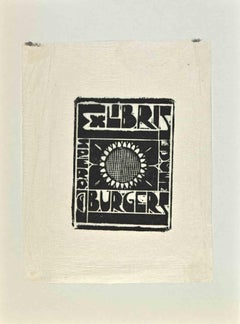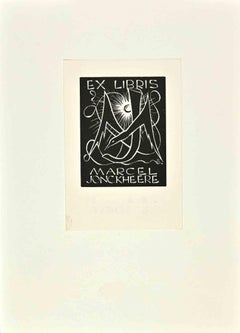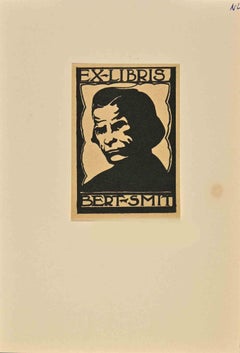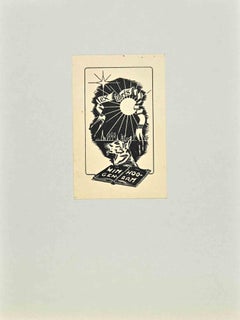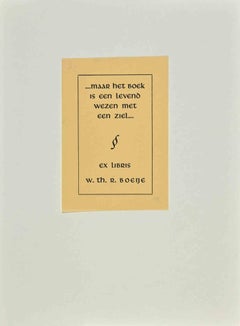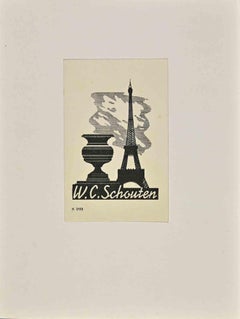Symbolist Prints and Multiples
to
105
454
131
92
10
2
Overall Width
to
Overall Height
to
20,640
19,638
10,650
5,836
5,277
2,641
1,476
1,394
1,155
809
773
421
341
191
96
42
38
38
34
2
85
579
26
16
145
103
117
7
11
21
13
5
5
516
163
8
440
287
221
125
116
93
79
40
37
35
34
29
28
28
25
19
19
18
17
15
233
217
98
88
60
31
359
362
217
Style: Symbolist
Ex Libris - Burgers - Woodcut - Mid 20th Century
Located in Roma, IT
Ex Libris - Burgers is a Modern Artwork realized in Mid-20th Century.
Ex Libris. B/W woodcut on tissue paper.
The work is glued on cardboard.
Total dimensions: 20x 15 cm.
Goo...
Category
Mid-20th Century Symbolist Prints and Multiples
Materials
Woodcut
Ex Libris - Marcel Jonckheere - Woodcut by Gerard Schelpe - 1959s
Located in Roma, IT
Ex Libris - Marcel Jonckheere is a Modern Artwork realized by Gerard Schelpe (1906-1973) in 1959..
Ex Libris. B/W woodcut on paper. Monogrammed on plate and dated on the back...
Category
1950s Symbolist Prints and Multiples
Materials
Woodcut
Ex Libris Bert-Smit - Woodcut - Mid 20th Century
Located in Roma, IT
Ex Libris Bert-Smit is a Modern Artwork realized in mid 20th Century.
B/W woodcut on paper.
The work is glued on cardboard.
Total dimensions: 20.5 x 14 cm.
Good conditions....
Category
Mid-20th Century Symbolist Prints and Multiples
Materials
Woodcut
Ex Libris Wim Hoogendam - Woodcut - Mid 20th Century
Located in Roma, IT
Ex Libris - Wim Hoogendam is a Modern Artwork realized in mid 20th Century.
B/W woodcut on paper.
The work is glued on cardboard.
Total dimensions: 20 x 15 cm.
Mint condit...
Category
Mid-20th Century Symbolist Prints and Multiples
Materials
Woodcut
Ex Libris W. Th. R. Boene - Woodcut - Mid 20th Century
Located in Roma, IT
Ex Libris W. Th. R. Boene is a Modern Artwork realized in mid 20th Century.
B/W woodcut on paper.
The work is glued on cardboard.
Total dimensions: 20 x 15 cm.
Mint conditi...
Category
Mid-20th Century Symbolist Prints and Multiples
Materials
Woodcut
Ex Libris W.C. Schouten - Woodcut - Mid 20th Century
Located in Roma, IT
Ex Libris W.C. Schouten is a Modern Artwork realized in mid 20th Century.
B/W woodcut on paper.
The work is glued on cardboard.
Total dimensions: 20x 15 cm.
Mint conditions...
Category
Mid-20th Century Symbolist Prints and Multiples
Materials
Woodcut
Ex Libris Biblioteca Cadeia Comarca de Beja - Woodcut Print - Mid-20th Century
Located in Roma, IT
Ex Libris Biblioteca Cadeia Comarca de Beja is an Artwork, woodcut print on paper. The work is glued on cardboard.
Total dimensions: 21 x 15.5 cm.
The artwork represents an elegan...
Category
Mid-20th Century Symbolist Prints and Multiples
Materials
Woodcut
Ex Libris Matea Serra - Woodcut Print - Mid-20th Century
Located in Roma, IT
Ex Libris Matea Serra is an Artwork, woodcut print on ivory-colored paper. The work is glued on cardboard.
Total dimensions: 21 x 15.5 cm.
The artwork represents a daily scene, thr...
Category
Mid-20th Century Symbolist Prints and Multiples
Materials
Woodcut
Ex Libris Imperiosa Fames - Woodcut by Jose Manuel Ballester - Mid-20th Century
Located in Roma, IT
Ex Libris Imperiosa Fames is an Artwork realized by the Spanish Artist, Jose Manuel Ballester
Woodcut print on paper. The work is glued on cardboard.
Total dimensions: 21 x 15 cm...
Category
Mid-20th Century Symbolist Prints and Multiples
Materials
Woodcut
Ex Libris - Wim Rengelink - Woodcut - 1989
Located in Roma, IT
Ex Libris - Wim Rengelink is a Modern Artwork realized in 1989.
B/W woodcut on paper.
The work is glued on cardboard.
Total dimensions: 20x 15 cm.
Excellent conditions .
...
Category
1890s Symbolist Prints and Multiples
Materials
Woodcut
Cupid and Motifs - Woodcut Print - Early 20th century
Located in Roma, IT
Cupid and Motifs is a woodcut print realized by the Anonymous artist in the early 20th century.
Good conditions with slight foxing.
Beautiful tiny and delicate artwork realized by ...
Category
Early 20th Century Symbolist Prints and Multiples
Materials
Woodcut
Ex Libris J. Veroaguer - Woodcut Print - Mid-20th Century
Located in Roma, IT
Ex Libris J. Veroaguer is a Modern Artwork realized in mid 20th Century.
B/W woodcut on paper.
The work is glued on cardboard.
Total dimensions: 21 x 15 cm.
Mint condition...
Category
Mid-20th Century Symbolist Prints and Multiples
Materials
Woodcut
Ex Libris Joan Roig I Montserrat - Woodcut Print - Mid-20th Century
Located in Roma, IT
Ex Libris Joan Roig I Montserrat is a Modern Artwork realized in mid 20th Century.
Ex Libris. B/W woodcut on paper.
The work is glued on cardboard.
Total dimensions: 21 x 1...
Category
Mid-20th Century Symbolist Prints and Multiples
Materials
Woodcut
Ex Libris De Swart - Woodcut Print - Mid-20th Century
Located in Roma, IT
Ex Libris De Swart is an Artwork, woodcut print on ivory-colored paper. The work is glued on cardboard.
Total dimensions: 20 x 15 cm.
The artwork represents a well-balanced composi...
Category
Mid-20th Century Symbolist Prints and Multiples
Materials
Woodcut
Ex Libris Luiz Da Cunha - Woodcut Print - Mid-20th Century
Located in Roma, IT
Ex Libris Luiz Da Cunha is an Artwork, woodcut print on paper. The work is glued on cardboard.
Total dimensions: 21 x 14.7 cm.
The artwork ripresents a minimalistic, clean design, ...
Category
Mid-20th Century Symbolist Prints and Multiples
Materials
Woodcut
Ex Libris Campos Monteiro Filho - Woodcut Print - Mid-20th Century
Located in Roma, IT
Ex Libris Campos Monteiro Filho is an Artwork, woodcut print on paper. The work is glued on cardboard.
Total dimensions: 21 x 15.5 cm.
The artwork represents a minimalistic, clean ...
Category
Mid-20th Century Symbolist Prints and Multiples
Materials
Woodcut
Ex Libris Joaquin Alvarez Calvo - Woodcut Print - Mid-20th Century
Located in Roma, IT
Ex Libris Joaquin Alvarez Calvo is a woodcut print on ivory-colored paper. The work is glued on cardboard.
Total dimensions: 21 x 15.5 cm.
The artwork represents a figure who holds...
Category
Mid-20th Century Symbolist Prints and Multiples
Materials
Woodcut
Illustration from the series "Les Fleurs du Mal" after Odilon Redon - 1923
By Odilon Redon
Located in Roma, IT
Illustration from the series "Les Fleurs du Mal" is an etching print realized after Odilon Redon and published by Henri Felury in 1923.
Monogrammed in the plate.
Good conditions.
...
Category
1920s Symbolist Prints and Multiples
Materials
Lithograph
Illustration from the Series "Les Fleurs du Mal" after Odilon Redon - 1923
By Odilon Redon
Located in Roma, IT
Illustration from the series "Les Fleurs du Mal" is an etching print realized after Odilon Redon and published by Henri Felury in 1923.
Monogrammed on the plate.
Good conditions.
...
Category
1920s Symbolist Prints and Multiples
Materials
Lithograph
Illustration from the series "Les Fleurs du Mal" after Odilon Redon - 1923
By Odilon Redon
Located in Roma, IT
Illustration from the series "Les Fleurs du Mal" is an etching print realized after Odilon Redon and published by Henri Felury in 1923.
Monogrammed on the plate.
Good conditions.
...
Category
1920s Symbolist Prints and Multiples
Materials
Lithograph
Portrait - after Odilon Redon - 1923
By Odilon Redon
Located in Roma, IT
Portrait is a prototype reproduction realized after Odilon Redon.
They belong to the suite "Odilon Redon Peintre, Dessinateur et Graveur", published by Henri Felury in 1923.
Title...
Category
1920s Symbolist Prints and Multiples
Materials
Photogravure
Portrait - Lithograph after Odilon Redon - 1923
By Odilon Redon
Located in Roma, IT
Portrait is a lithograph realized after Odilon Redon.
They belong to the suite "Odilon Redon Peintre, Dessinateur et Graveur", published by Henri Felury in 1923.
Good conditions, ...
Category
1920s Symbolist Prints and Multiples
Materials
Lithograph
Anémone Humaine Fleurs - Lithograph after Odilon Redon - 1923
By Odilon Redon
Located in Roma, IT
Anémone Humaine Fleurs is a lithograph realized after a watercolor by Odilon Redon.
It belongs to the suite "Odilon Redon Peintre, Dessinateur et Graveur", published by Henri Felur...
Category
1920s Symbolist Prints and Multiples
Materials
Lithograph
Ballerinas - Photolithograph After Constantin Guys - Early 20th Century
Located in Roma, IT
Ballerinas is a photolithograph print on ivory-colored paper, glued on a greenish Passepartout realized in the early 20 century After Constantin Guys
Good conditions.
The critical ...
Category
Early 20th Century Symbolist Prints and Multiples
Materials
Lithograph
Ballerinas - Photolithograph after C. Guys - Early 20th Century
Located in Roma, IT
Ballerinas is a photolithograph print on ivory-colored paper, glued on a greenish Passepartout realized in the early 20 century After Constantin Guys
Good conditions.
The artwork ...
Category
Early 20th Century Symbolist Prints and Multiples
Materials
Lithograph
Andra Samelson, Jalü #6 archival pigment print on canvas, Ed. 1/5, Rainbows
Located in Darien, CT
Rainbow Light can manifest anywhere and anytime, representing ominscience and it can dissolve instantly, representing impermanence. It is without shadow and represents awareness with...
Category
2010s Symbolist Prints and Multiples
Materials
Archival Pigment
Andra Samelson, Jalü #7, archival pigment print, on canvas, Ed. 1/5, Rainbows
Located in Darien, CT
Rainbow Light can manifest anywhere and anytime, representing ominscience and it can dissolve instantly, representing impermanence. It is without shadow and represents awareness with...
Category
2010s Symbolist Prints and Multiples
Materials
Archival Pigment
Ex Libris PF - Woodcut by Michel Fingesten - 1936
Located in Roma, IT
Ex Libris PF is a woodcut print by Michel Fingesten, realized in 1936.
Hand signed, included a white cardboard passpartout (30x24 cm).
In excellent conditions: As good as new.
Michel Fingesten (1884 - 1943) was a Czech painter and engraver of Jewish origin. He is considered one of the greatest Ex Libris artists in history. From an Austrian weaver father and a Jewish mother...
Category
Early 20th Century Symbolist Prints and Multiples
Materials
Woodcut
Ex Libris GB - Woodcut by Michel Fingesten - 1936
Located in Roma, IT
Ex Libris GB is a woodcut print by Michel Fingesten in 1936.
Hand signed , included a white cardboard passpartout (30x24 cm).
In excellent conditions: As good as new.
Michel Fingesten (1884 - 1943) was a Czech painter and engraver of Jewish origin. He is considered one of the greatest Ex Libris artists in history. From an Austrian weaver father and a Jewish mother...
Category
Early 20th Century Symbolist Prints and Multiples
Materials
Woodcut
Women and Dagger - Woodcut by Michel Fingesten - 1936
Located in Roma, IT
Women and Dagger (ex Libris) is a woodcut print by Michel Fingesten, in 1936.
Hand signed with pencil, included a white cardboard passpartout (30x24 cm).
In excellent conditions: As good as new.
Michel Fingesten (1884 - 1943) was a Czech painter and engraver of Jewish origin. He is considered one of the greatest Ex Libris artists in history. From an Austrian weaver father and a Jewish mother from Trieste. At 16 he studied at the Vienna Academy, together with Oskar Kokoschka. From 1902 to 1906 he wandered around America, and then Australia, before arriving in Palermo in 1907. He went up the peninsula via Trieste and returning to Germany, first settling in Munich in Franz von Stuck's studio, practicing caricature and small format graphics and then in Berlin.
In 1913 he began to record. He returned to Italy in 1935 to visit his maternal relatives from Trieste and remained there because of the racial persecutions to which the Jews in Silesia were subject, settling in Milan. In this period he recorded about 500 exlibris. On 9 October 1940 he was arrested and interned as a foreigner in the camp of Civitella del Tronto and then of Ferramonti, (Cosenza) from November 1941 and will be accused by the Nazis of having painted degenerate art ("Entartete Kunst...
Category
Early 20th Century Symbolist Prints and Multiples
Materials
Woodcut
Ex Libris G.B. - Woodcut by Michel Fingesten - 1937
Located in Roma, IT
Ex Libris G.B. is a woodcut print by Michel Fingesten, in 1937.
Hand signed , included a white cardboard passpartout (30x24 cm).
In excellent conditions: As good as new.
Michel Fingesten (1884 - 1943) was a Czech painter and engraver of Jewish origin. He is considered one of the greatest Ex Libris artists in history. From an Austrian weaver father and a Jewish mother from Trieste. At 16 he studied at the Vienna Academy, together with Oskar Kokoschka. From 1902 to 1906 he wandered around America, and then Australia, before arriving in Palermo in 1907. He went up the peninsula via Trieste and returning to Germany, first settling in Munich in Franz von Stuck's studio, practicing caricature and small format graphics and then in Berlin.
In 1913 he began to record. He returned to Italy in 1935 to visit his maternal relatives from Trieste and remained there because of the racial persecutions to which the Jews in Silesia were subject, settling in Milan. In this period he recorded about 500 exlibris. On 9 October 1940 he was arrested and interned as a foreigner in the camp of Civitella del Tronto and then of Ferramonti, (Cosenza) from November 1941 and will be accused by the Nazis of having painted degenerate art ("Entartete Kunst...
Category
Early 20th Century Symbolist Prints and Multiples
Materials
Woodcut
Andra Samelson, Jalü #4, archival pigment print on canvas, Ed. 1/5, Rainbows
Located in Darien, CT
Rainbow Light can manifest anywhere and anytime, representing ominscience and it can dissolve instantly, representing impermanence. It is without shadow and...
Category
2010s Symbolist Prints and Multiples
Materials
Archival Pigment
Au Pays de la Vierge - Original Woodcut Print by Pierre-Eugène Vibert - 1897
Located in Roma, IT
Au pays de la Vierge is an original artwork realized by French artist Pierre Eugène Vibert .
It's an original woodcut print, signed on plate on...
Category
19th Century Symbolist Prints and Multiples
Materials
Woodcut
Joe Jackson; Look Sharp, 1979, Vintage Gelatin Silver Print, winklerpicker shoes
Located in London, GB
Brian Griffin
Joe Jackson - Look Sharp, 1979
Vintage Gelatin Silver Print, Framed; museum mount board, antireflective art glass, oak frame
Image size; 11 4/5 × 15 7/10 in 30 × 40 cm...
Category
1970s Symbolist Prints and Multiples
Materials
Glass, Oak, Photographic Film, Photographic Paper, Black and White, Brom...
Andra Samelson, Jalü #5 archival pigment print, Ed. 3/5, Rainbows reflections
Located in Darien, CT
Rainbow Light can manifest anywhere and anytime, representing ominscience and it can dissolve instantly, representing impermanence. It is without shadow and represents awareness with...
Category
2010s Symbolist Prints and Multiples
Materials
Archival Pigment
Andra Samelson, Jalü #7, archival pigment print, Ed. 1/5, Rainbows reflections
Located in Darien, CT
Rainbow Light can manifest anywhere and anytime, representing ominscience and it can dissolve instantly, representing impermanence. It is without shadow and represents awareness with...
Category
2010s Symbolist Prints and Multiples
Materials
Archival Pigment
Andra Samelson, Jalü #6 archival pigment print, Ed. 1/5, Rainbows reflections
Located in Darien, CT
Rainbow Light can manifest anywhere and anytime, representing ominscience and it can dissolve instantly, representing impermanence. It is without shadow and represents awareness with...
Category
2010s Symbolist Prints and Multiples
Materials
Archival Pigment
Ex Libris RS - Woodcut by Michel Fingesten - Early 20th Century
Located in Roma, IT
"Ex Libris RS" is an original woodcut artwork on creamy paper by Michel Fingesten, Early 20th Century.
Hand-signed on the lower right and with notes in pencil.
In excellent conditio...
Category
Early 20th Century Symbolist Prints and Multiples
Materials
Woodcut
Die Tanzerin Gertrud Bodenwieser Héliogravure by Franz von Bayros - 20th Century
Located in Roma, IT
"Die Tanzerin Gertrud Bodenwieser" is an original colored héliogravure on cream-colored cardboard realized by Choisy Le Conin, pseudonym of Franz Von Bayros (Agram, 1866 – Vienna, 1...
Category
Early 20th Century Symbolist Prints and Multiples
Materials
Engraving
Weihnacht - Vintage Héliogravure by Franz von Bayros - 20th Century
Located in Roma, IT
"Weihnacht" is an original Black and white héliogravure on cream-colored cardboard realized by Choisy Le Conin, pseudonym of Franz Von Bayros (Agram, 1866 – Vienna, 1924).
From Map...
Category
Early 20th Century Symbolist Prints and Multiples
Materials
Engraving
Lugenbrucke - Vintage Héliogravure by Franz von Bayros - Early 20th Century
Located in Roma, IT
"Lugenbrucke" is an original Black and white héliogravure on cream-colored cardboard realized by Choisy Le Conin, pseudonym of Franz Von Bayros (Agram, 1866 – Vienna, 1924).
From M...
Category
Early 20th Century Symbolist Prints and Multiples
Materials
Engraving
Verfuhrung - Vintage Héliogravure by Franz von Bayros - Early 20th Century
Located in Roma, IT
"Verfuhrung" is an original Black and white héliogravure on cream-colored cardboard realized by Choisy Le Conin, pseudonym of Franz Von Bayros (Agram, 1866 – Vienna, 1924).
From Ma...
Category
Early 20th Century Symbolist Prints and Multiples
Materials
Engraving
Ex Libris - Woodcut by M. Fingesten - Early 1900
Located in Roma, IT
Ex Libris is an original woodcut print realized by Michel Fingesten.
Hand-signed on the lower center and hand written notes.
Mint conditions.
Sheet Dimension: 17.3 x11
Ex Libri...
Category
Early 20th Century Symbolist Prints and Multiples
Materials
Woodcut
Antoine Georges Marie Rochgrosse
Located in New York, NY
Rochgrosse, Antoine Georges Marie. Poems Chantes/Gustave Carpentier /Paris/Henri Tellier, Editeur. 1896. 7 Color lithograph.
Das fruhe Plakat 750 (Music Sheet).
French painter, pri...
Category
1880s Symbolist Prints and Multiples
Materials
Lithograph
WENDINGEN - Number 3/4 of the 9th series 1928 dedicated to Jan Toorop
Located in New York, NY
WENDINGEN
Number 3/4 of the 9th series (1928), dedicated to Jan Toorop, edited by H.C.Verkruysen, Dutch text,
cover designed by R.N.Roland Holst. Lithogr...
Category
1920s Symbolist Prints and Multiples
Materials
Lithograph
BOSBOOM. 1917.
Located in New York, NY
ROLAND HOLST, R.N. (Richard) (1868-1938). “Eere Tentoonstelling Bosboom/ 1817 1917/ Pulchri-Studio ‘s Gravenhage/ 21 Apr[il] 31 Mei”. Color lithograph (pa...
Category
1910s Symbolist Prints and Multiples
Materials
Lithograph
Wendingen, Issue 8/9, Cover by R.N. Roland Holst, 1923.
Located in New York, NY
WENDINGEN- 5-8/9 1923
R. N. ROLAND HOLST. Shells, the Wonder Forms of the Sea. Published November 1923.
Strange resemblance’s by R. N. Roland Holst; Na...
Category
1920s Symbolist Prints and Multiples
Materials
Lithograph
"Emmanuelle, " Original Lithograph Printed in Blue signed by Maurice Denis
Located in Milwaukee, WI
"Emmanuelle" is an original lithograph by Maurice Denis. It is a birth announcement for the artist's granddaughter and was printed in blue.
5 7/8" x 7...
Category
1930s Symbolist Prints and Multiples
Materials
Lithograph
Girl with Lyre. 1905 [before lettering].
By Henri-Jean Guillaume Martin
Located in New York, NY
Martin, Jean Guillaume Henri.
Girl with Lyre. 1905 [before lettering]. on Linen. Rare
Henri Jean Guillaume Martin was a French painter known for his Neo-Impressionist paintings. L...
Category
Early 1900s Symbolist Prints and Multiples
Materials
Lithograph
"L'Etendard de la Vigilance, " Original Etching & Serigraph signed by Joel Cazaux
Located in Milwaukee, WI
"L'Etendard De La Vigilance" is an original etching and serigraph by Joel Cazaux. The artist signed the piece lower right, and wrote the edition number 38/100 in the lower left, and ...
Category
1970s Symbolist Prints and Multiples
Materials
Etching, Screen
Eye Infection As A Result Of Ingesting Poison - Print of the hand colour photo
Located in London, GB
© Katie Eleanor, IV., Eye Infection As A Result Of Ingesting Poison
Series: Saint Wanderer's Hospital, 2015
Archival Pigment Print of the hand Coloured Photograph on cotton fine art paper, custom frame
7 1/2 × 5 7/10 in
19 × 14.5 cm (unframed print)
35 x 30.5 cm (Framed : Museum mount-board, antireflective art glass in hardwood custom frame)
Edition of 15
Framed or Unframed option available
Saint Wanderer’s Hospital depicts a fictional tale birthed from the artist’s inherent need to find splendour in the idea of sickness.
Rooted first from her own words, Katie used the idea of illustrating as a form of personal art therapy by immersing herself in the realm of the otherworldly characters. Every aspect of each scene was created by Katie alone, from building and designing the sets to printing and hand-colouring the final images. In this act, over the year long course of the projects creation, the artist managed to make certain turmoil in her personal life bearable.
In the world of the hospital, the artist adapts the role of medical photographer – creating accurate portraits of each character’s condition as a record for the hospitals future use.
The final series comprises of 8 ‘specimen cased...
Category
2010s Symbolist Prints and Multiples
Materials
Cotton, Watercolor, Archival Pigment
"Portrait of Sculptor James Vibert" Copper Plate Heliogravure
Located in Chicago, IL
2018 marks the centenary anniversary of Ferdinand Hodler’s death. In that 100 years time, the art world’s esteem of this important artist has proved fickle. It has shifted from extolling his artistic merits during his lifetime to showing something of a feigned disdain- more reflective of the world political order than a true change of heart for Hodler’s work. After years of Hodler being all but a footnote in the annals of art history and generally ignored, finally, the pendulum has righted itself once again. Recent retrospective exhibitions in Europe and the United States have indicated not only a joyful rediscovery of Hodler’s art but a firm conviction that his work and world view hold particular relevance today. DAS WERK FERDINAND HODLERS is not only a collection of printed work reflecting the best of all of his painted work created up to 1914 just before the outbreak of World War I, the portfolio itself is an encapsulation of Hodler’s ethos, Parallelisme.
Hodler developed his philosophy of Parallelisme as a unifying approach to art which strips away detail in search of harmony. By means of abstraction, symmetry and repetition, Hodler sought ways to depict Nature’s essence and her fundamental, universal order. He believed these universal laws governing the natural, observable world extend to the spiritual realm. Symbolist in nature with Romantic undertones, his works are equally portraits of these universal concepts and feelings governing all life as they are a visual portrait in the formal sense. Whether his subject is a solitary tree, a moment in battle, mortal fear, despair, the awe inspired by a vast mountain range, a tender moment or even the collective conviction in a belief, Hodler unveils this guiding principle of Parallelisme.
Several aspects of Hodler’s portfolio reinforce his tenets of Parallelisme. The Table of Contents clearly preferences a harmonious design over detail. The two columns, consisting of twenty lines each, list the images by order of appearance using their German titles. The abbreviated titles are somewhat cryptic in that they obscure the identities of the sitters. Like the image Hodler presents, they are distillations of the sitter without any extraneous details. This shortening was also done in an effort to maintain a harmonious symmetry of the Table of Contents, themselves, and keep titles to a one-line limit. The twenty-fourth title: “Bildnis des Schweizerischen Gesandten C.” was so long, even with abbreviation, that it required two lines; so, for the sake of maintaining symmetry, the fortieth title: “Bauernmadchen” was omitted from the list. This explains why the images are not numbered. Hodler’s reasoning is not purely esoteric. Symmetry and pattern reach beyond mere formal design principles. Finding sameness and imposing it over disorder goes to the root of Hodler’s identity and his art. A Swiss native, Hodler was bi-lingual and spoke German and French. Each printed image, even number forty, have titles in both of Hodler’s languages. Certainly, there was a market for Hodler’s work among francophones and this inclusion may have been a polite gesture to that end; however, this is the only place in the portfolio which includes French. With German titles at the lower left of each image, Hodler’s name at bottom center and corresponding French titles at the lower right of each image, there is a harmony and symmetry woven into all aspects of the portfolio. This holds true for the page design, as it applies to each printed image and as it describes the Swiss artist himself. Seen in this light, Hodler’s portfolio of printed work is the epitome of Hodler’s Parallelisme. DAS WERK FERDINAND HODLERS is also one of the most significant documents to best tell the story of how Hodler, from Switzerland, became caught between political cross-hairs and how the changing tides of nations directly impacted the artist during his lifetime as well as the accessibility of his art for generations to come.
The Munich-based publisher of the portfolio, R. Piper & Co., Verlag, plays a crucial role in this story. Publishing on a wide range of subjects from philosophy and world religion to music, literature and the visual arts; the publisher’s breadth of inquiry within any one genre was equal in scope. Their marketing strategy to publish multiple works on Hodler offers great insight as to what a hot commodity Hodler was at that time. R.Piper & Co.’s Almanach, which they published in 1914 in commemoration of their first ten years in business, clearly illustrates the rapid succession- strategically calculated for achieving the deepest and broadest impact - in which they released three works on Hodler to hit the market by the close of 1914. DAS WERK FERDINAND HODLERS was their premier publication. It preceded C.A. Loosli’s Die Zeichnungen Ferdinand Hodlers, a print portfolio after 50 drawings by Hodler which was released in Autumn of 1914 at the mid-level price-point of 75-150 Marks; and a third less expensive collection of prints after original works by Hodler, which had not been included in either of the first two portfolios, was released at the end of that year entitled Ferdinand Hodler by Dr. Ewald Bender.
The title and timing of DAS WERK FERDINAND HODLERS' debut leaves little doubt as to the connection it has with another avant-garde portfolio of art prints, Das Werk Gustav Klimts, released in 5 installments from 1908 -1914 by Galerie Miethke in Vienna. Hodler, himself, was involved in Klimt’s ground-breaking project. As the owner of Klimt’s 1901 painting, “Judith with the Head of Holifernes” which appears as the ninth collotype print in the second installment of Das Werk Gustav Klimts, Hodler was obliged to grant access of the painting to the art printers in Vienna for them to create the collotype sometime before 1908. Hodler had been previously invited in 1904 to take part in what would be the last exhibition of the Vienna Secession before Klimt and others associated with Galerie Miethke broke away. In an interview that same year, Hodler indicated that he respected and was impressed by Klimt. Hodler’s esteem for Klimt went beyond the art itself; he emulated Klimt’s method aimed at increasing his market reach and appeal to a wider audience by creating a print portfolio of his painted work. By 1914, Hodler and his publisher had the benefit of hindsight to learn from Klimt’s Das Werk publication.
Responding to the sluggish sales of Klimt’s expensive endeavor, Hodler’s publisher devised the same diversified 1-2-3 strategy for selling Hodler’s Das Werk portfolio as they did with regards to all three works on Hodler they published that year. For their premium tier of DAS WERKS FERDINAND HODLERS, R. Piper & Co. issued an exclusive Museum quality edition of 15 examples on which Hodler signed each page. At a cost of 600 Marks, this was generally on par with Klimt’s asking price of 600 Kronen for his Das Werk portfolio. A middle-tiered Preferred edition of 30, costing somewhat less and with Hodler’s signature only on the Title Page, was also available. The General edition, targeting the largest audience with its much more affordable price of 150 Marks, is distinguishable by its smaller size.
Rather than use the subscription format Miethke had chosen for Klimt’s portfolios which proved to have had its challenges, R. Piper & Co. employed a different strategy. In addition to instantly gratifying the buyer with all 40 of the prints comprising DAS WERK FERDINAND HODLERS and the choice among three price points, they advertised in German journals a fourth possibility of ordering single prints from them directly. These printed images are easily discernible from the three complete folio editions. The paper size of the single purchased images is of the larger format like the Museum and Preferred editions, measuring 65 h x 50 w cm; however, the paper itself is the same copper print paper used in the General edition and then mounted on poster board. The publishing house positioned itself to be a direct retailer of Hodler’s art. They astutely recognized the potential for profitability and the importance, therefore, of having proprietary control over his graphic works.
R. Piper & Co. owned the exclusive printing rights to Hodler’s best work found in their three publications dating from 1914. That same year, a competing publication out of Weimar entitled Ferdinand Hodler: Ein Deutungsversuch von Hans Muhlestein appeared. Its author, a young scholar, expressed his frustration with the limited availability of printable work by Hodler. In his Author’s Note on page 19, dated Easter, 1914, Muhlestein confirms that the publisher of Hodler’s three works from that same year owned the exclusive reproductive rights to Hodler’s printed original work. He goes further to explain that even after offering to pay to use certain of those images in his book, the publisher refused. Clearly, a lot of jockeying for position in what was perceived as a hot market was occurring in 1914.
Instead, their timing couldn’t have been more ill-fated, and what began with such high hopes suddenly found a much different market amid a hostile climate. The onset of WWI directly impacted sales. Many, including Ferdinand Hodler, publicly protested the September invasion by Germany of France in which the Reims Cathedral, re-built in the 13th century, was shelled, destroying priceless stained glass and statuary and burning off the iron roof and badly damaging its wooden interior. Thomas Gaehtgens, Director of the Getty Research Institute describes how the bombing of Reims Cathedral triggered blindingly powerful and deeply-felt ultra-nationalistic responses: “The event profoundly shocked French intellectuals, who for the most part had an intense admiration for German literature, music and art. By relying on press accounts and abstracting from the visual propagandistic content, they were unable to interpret the siege of Reims without turning away from German culture in disgust. Similarly, the German intelligentsia and bourgeoisie were also shocked to find themselves described as vandals and barbarians. Ninety-three writers, scientists, university professors, and artists signed a protest, directed against the French insults, that defended the actions of the German army.”
In similar fashion, a flurry of open letters published in German newspapers and journals as well as telegrams and postcards sent directly to Hodler following his outcry in support of Reims reflected the collectively critical reaction to Hodler’s position. Loosli documents that among the list of telegrams Hodler received was one from none other than his publisher in Germany, R.Piper & Co. Allegiances were questioned. The market for Hodler in Germany immediately softened. Matters worsened for the publisher beyond the German backlash to Hodler and his loss of appeal in the home market; with the war in full swing until 1918, there was little chance a German publisher would have much interest coming from outside of Germany and Austria. Following the war and Hodler’s death in 1918, the economy in Germany continued to spiral out and just 5 years later, hyper-inflation had rendered its currency worthless vis-a-vis its value in the pre-war years. Like the economy, Hodler’s reputation was slow to find currency in these difficult times. Even many French art fans had turned sour on Hodler as they considered his long-standing relationship in German and Austrian art circles. Thus, the portfolio’s rarity in Hodler’s lifetime and, consequently, the availability of these printed images from DAS WERK FERDINAND HODLERS since his death has been scarce.
In many ways, Hodler and his portfolios were casualties of war. Thwarted from their intended purpose of reaching a wide audience and show-casing Parallelisme, Hodler’s unique approach to art, this important, undated work has been both elusive and shrouded in mystery. Perhaps DAS WERK FERDINAND HODLERS was left undated as a means of affirming the timelessness of Hodler’s art. Digging back into the past, Hodler’s contemporaries, like R. Piper, C.A. Loosli and Hans Muhlestein, indeed provide the keys to unequivocally clarify what has largely been mired in obscurity. Just after Hodler’s death, the May, 1918 issue of the Burlington Review ran a small column which opined hope for better access to R.Piper & Co.’s DAS WERK FERDINAND HODLERS; 100 years later, it is finally possible. Hodler’s voice rings out through these printed works. Once more, his modern approach to depicting portraits, landscapes and grand scale scenes of Swiss history speak to us of what is universal. Engaging with any one of these images is the chance to connect to Hodler’s vision and his world view- weltanschauung in German, vision du monde in French- however one expresses these concepts through language, its message embedded in his work is the same: “We differ from one another, but we are like each other even more. What unifies us is greater and more powerful than what divides us.” Today, Hodler’s art couldn’t be more timely.
FERDINAND HODLER (SWISS, 1853-1918) explored Parallelisme through figurative poses evocative of music, dance and ritual. His images of sex, night, desertion and death as well as his many landscapes exploring the universal longing for harmony with Nature are unique and important works embodying a Symbolist paradigm. Truly a Modern Master, Hodler’s influence can be felt in the work of Gustav Klimt and Kolomon Moser...
Category
1910s Symbolist Prints and Multiples
Materials
Paper
Le jour enfin paraît
By Odilon Redon
Located in New York, NY
Odilon Redon (1840-1916), Le jour enfin paraît, lithograph, 1896, signed in pencil upper left, plate 24 from the portfolio The Temptation of Saint Anthony...
Category
1890s Symbolist Prints and Multiples
Materials
Lithograph
Eve
Located in West Hollywood, CA
A magnificent, rare original etching by Scottish artist William Russell Flint.
This etching was just acquired from the estate of an important American artist where it has resided fo...
Category
18th Century and Earlier Symbolist Prints and Multiples
Materials
Etching
Symbolist prints and multiples for sale on 1stDibs.
Find a wide variety of authentic Symbolist prints and multiples available for sale on 1stDibs. Works in this style were very popular during the 21st Century and Contemporary, but contemporary artists have continued to produce works inspired by this movement. If you’re looking to add prints and multiples created in this style to introduce contrast in an otherwise neutral space in your home, the works available on 1stDibs include elements of orange, blue and other colors. Many Pop art paintings were created by popular artists on 1stDibs, including Michel Fingesten, Abel Pann, Franz von Bayros (Choisi Le Conin), and Ferdinand Hodler & R. Piper & Co.. Frequently made by artists working with Lithograph, and Woodcut Print and other materials, all of these pieces for sale are unique and have attracted attention over the years. Not every interior allows for large Symbolist prints and multiples, so small editions measuring 1.58 inches across are also available. Prices for prints and multiples made by famous or emerging artists can differ depending on medium, time period and other attributes. On 1stDibs, the price for these items starts at $55 and tops out at $378,675, while the average work sells for $462.
